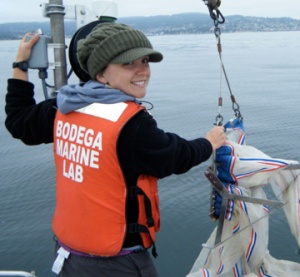By Carole Rosner
Every gifted person has a unique story. The following story is part of a series of posts depicting the many faces of gifted by highlighting gifted children and adults we have found through IEA programs. IEA’s Apprenticeship Program – mentioned in this story – links gifted high school students from across the country with mentors who advance each participant’s skills through the application of knowledge and exposure to real world experiences.

Marley Jarvis
2003 Apprentice, Caltech
PhD Candidate, University of Oregon
In the summer of 2003, an IEA Apprenticeship opportunity in Pasadena grabbed the attention of teenager Marley Jarvis. To apprentice with Dr. Patrick Collier in the Chemistry Department at Caltech was just what Marley was looking for.
“In high school, I was really interested in studying the brain. This Apprenticeship was the only one that year that touched on neurobiology. I applied since it was also one of the only programs that offered lots of research experience for a high schooler that I found,” Marley explained.
One of Marley’s most memorable experiences as an Apprentice was the first lab meeting she attended at Caltech. “Listening to the Collier lab members talk about their research was when I first really thought about creating circuits that mimic neurotransmitter signaling in the brain. The reductionist idea of being able to break down the brain into its simplified parts – an electrical circuit – absolutely fascinated me. I could see why they were all hooked!”
As an Apprentice, Marley worked closely in the lab with Dr. Maria Esplandiu, a Postdoctoral Fellow, to grow single-wall carbon nanotubes to use as electrodes in circuits that mimicked the brain. At night, Marley joined the other Apprentices on the campus of Caltech for sightseeing and various activities. “It was also great to hear about the other projects from the other students in the program when everyone came ‘home’ to the dorms,” Marley reflected.
I asked Marley what it was like to go back to being a high school student after her Apprenticeship. “I got a lot out of having this research experience in an organized program setting. The experience did give me confidence, both socially and academically. This was my first real glimpse into life as a researcher or what being an undergraduate or graduate student in a science field would look like,” she said.
Marley is currently a PhD candidate in her fourth year of a doctoral program at the University of Oregon focusing on biological oceanography. “I live and work full time out at their marine lab on the Oregon coast. I study fronts in the ocean. Just like in the atmosphere, fronts in the ocean separate different masses and are quite common. A front is a boundary between two different types of water, and I study how these features affect the distribution of organisms and nutrients in the nearshore ocean. Despite my biology background, I’ve really come to love fluid dynamics and am studying current patterns in the coastal ocean using drogues – think sort of an underwater kite that moves with the current below the surface. The underwater kite, or drogue, is attached to a surface float by a long string. The surface float has a GPS in it that records the track of the drogue and tells me what the currents are doing at different depths. I do a lot of small boat work very close to shore, where currents get quite complicated.”
When Marley is done with her PhD, she said she’d like to continue to work in nearshore hydrodynamics. “I’ve learned that we know the least about currents in the part of the ocean we live in close contact with. The first few miles out to sea has very complicated hydrodynamics as coastal currents interact with islands, sea stacks, coastal promontories and other coastline topography. A lot of our sea food, productivity and marine biodiversity occur in this narrow strip of nearshore ocean, and I am always fascinated by how currents move in the ocean and affect everything in it.”
“I see myself continuing to work as a researcher, hopefully back in northern California where I grew up. I really enjoy communicating science in an informal setting. I get a lot of joy in talking about “difficult” topics like physics and oceanography with people who assume they are not smart enough to get it. I’d love to start a girls’ physical oceanography club. I hope to be able to continue as a researcher but to leave time to work in science outreach. I love having conversations outside of the normal academic world to see the commonalities we all have in our view of the future of the ocean and what we’d like to see.”
For Marley, the IEA Apprenticeship program was educational, lots of fun and a “great way to peek down a potential future path.”
“I can’t say that this Apprenticeship was a stepping stone to biological oceanography, but it was definitely a stepping stone to becoming a scientific researcher. Taking science classes is completely different than conducting research, and this program was an excellent first look into a research lab.”

